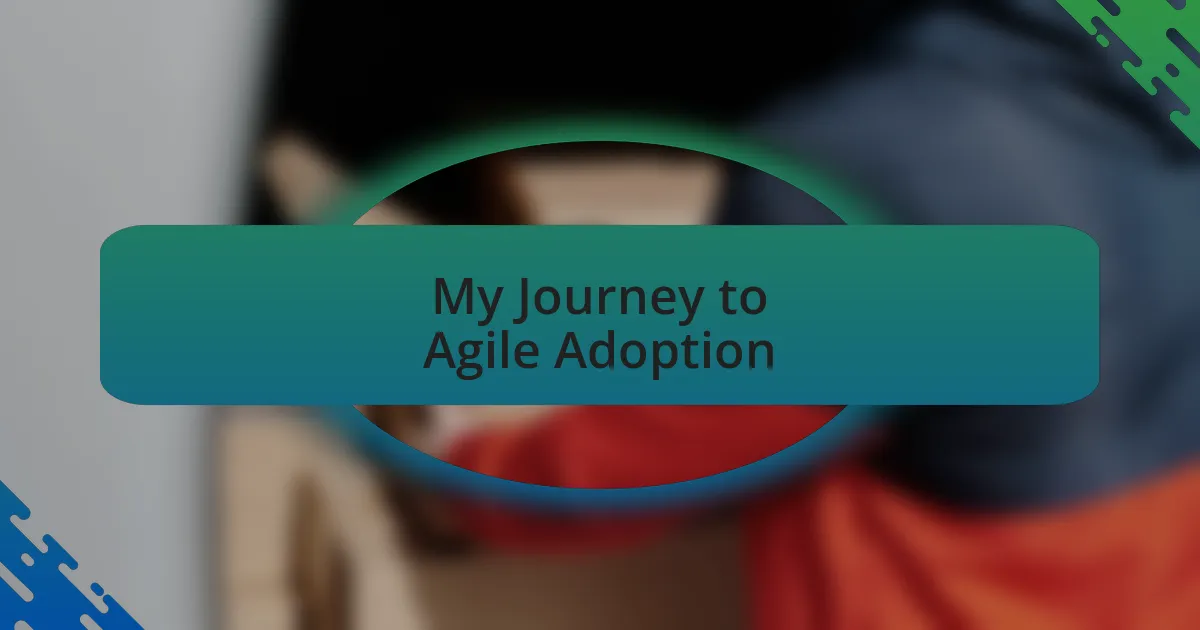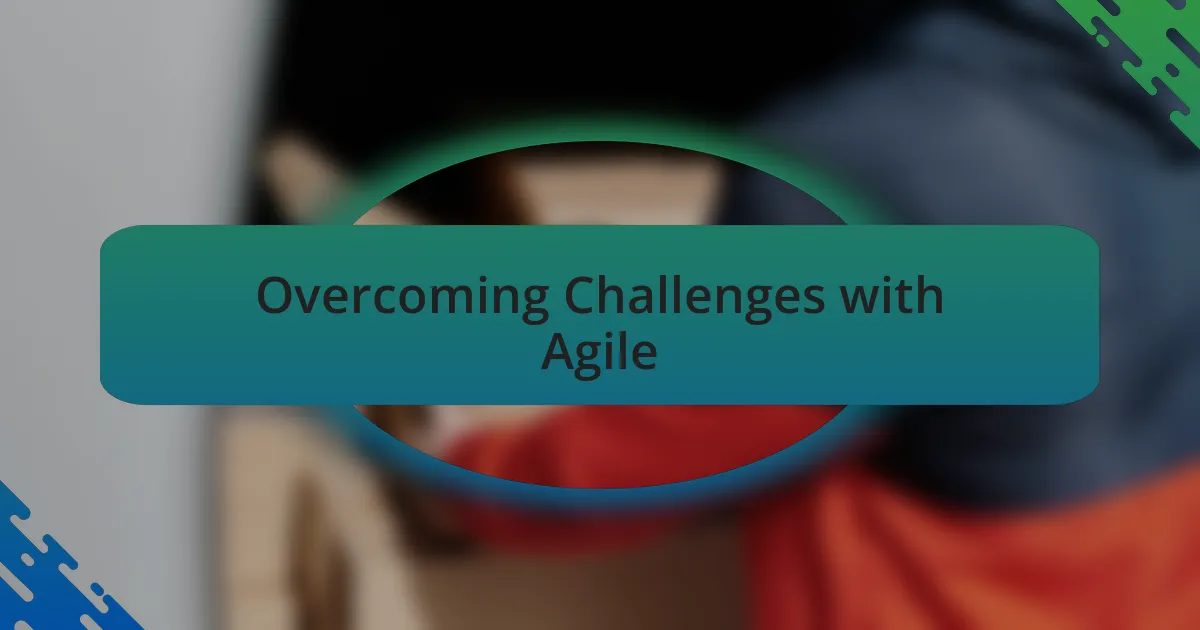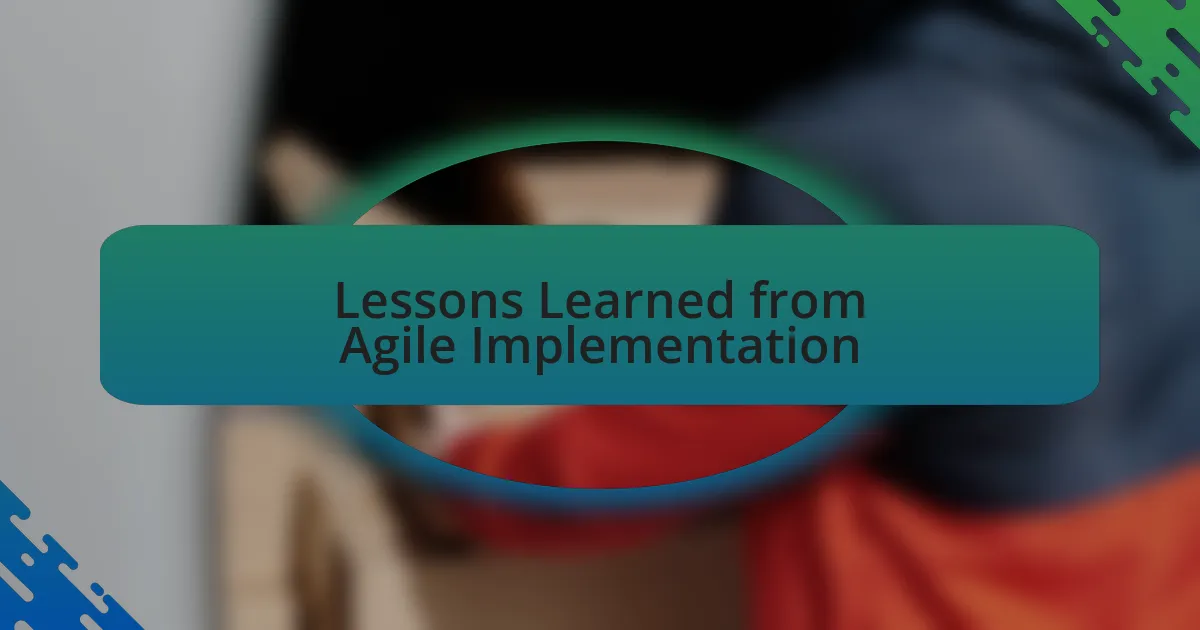Key takeaways:
- Agile methodology fosters flexibility and collaboration through short cycles (sprints) and constant feedback, enhancing team ownership and accountability.
- Key principles include customer collaboration, frequent delivery of working software, and regular retrospectives, which promote adaptability and continuous improvement.
- Challenges like changing requirements are embraced as opportunities for growth, encouraging teamwork and open communication to maintain team well-being.
- Transparency and active stakeholder engagement significantly improve project outcomes and foster trust within the team.

Understanding Agile Methodology
Agile methodology is all about flexibility and collaboration. When I first encountered Agile, it felt like a breath of fresh air from the rigid structures I was used to. Have you ever felt constricted by strict project plans? Agile invites teams to work in short cycles, called sprints, allowing for continuous feedback and improvement.
What truly amazed me about Agile was its emphasis on team communication. In my experience, daily stand-up meetings transformed our collaboration, creating a space where everyone felt empowered to voice concerns and share progress. It was remarkable to witness how this simple change fostered a sense of ownership and accountability among team members.
Adopting Agile not only changed the way I managed projects but also shifted my mindset. I found that embracing uncertainty and adapting to change became vital skills. Have you ever noticed how projects can shift based on evolving client needs? With Agile, my team learned to welcome these changes rather than fear them, resulting in more innovative solutions and satisfied clients.

Key Principles of Agile Practices
The cornerstone of Agile practices is the principle of customer collaboration over contract negotiation. I vividly remember a project where our initial specifications shifted dramatically halfway through development. Instead of getting stuck in a contractual rut, we engaged directly with the client, which not only clarified their vision but also deepened our relationship. Have you ever found that direct communication can uncover needs that documents alone might miss? This experience taught me the importance of remaining adaptable and responsive to client feedback.
Another key principle is delivering working software frequently, which motivates the team and ensures we’re aligned with user needs. I recall a project where we launched a basic version of our product in just a month. The thrill of receiving user feedback early on was invigorating and allowed us to pivot based on real-world data rather than assumptions. Isn’t it fascinating how receiving actual user input can refine a project more effectively than endless discussions? This practice turned out to be a game-changer for both team morale and project success.
Lastly, Agile promotes a culture of reflection and iteration through regular retrospectives. I remember these sessions being a bit daunting at first, as we had to confront our failures and inefficiencies openly. Yet, they became a safe space for growth and learning. How often do we truly evaluate our processes and seek improvement? This principle empowered us to evolve continuously, cultivating a team that not only meets challenges head-on but also embraces opportunities for enhancement.

My Journey to Agile Adoption
Adopting Agile was a significant turning point in my project management approach. I can still remember the mix of excitement and apprehension I felt during our first sprint planning meeting. The idea of breaking our projects into smaller, manageable chunks was intriguing, yet it felt like we were stepping into uncharted territory. Have you ever faced that mix of fear and exhilaration when trying something new?
Gradually, I discovered the value of the daily stand-ups. Initially, I felt they were just another meeting to squeeze into my busy schedule, but they transformed into a lifeline for the team. Sharing progress and roadblocks daily built a sense of accountability and camaraderie that I had never experienced before. Isn’t it interesting how a simple five-minute check-in can redefine team dynamics?
One of the most profound changes was the shift in how I approached deadlines. Instead of viewing them as rigid endpoints, I learned to treat them like milestones on a journey. I remember a time when we shifted our focus from finishing tasks to ensuring that each delivered feature truly met user needs. This perspective not only reduced stress but also fostered a culture of quality over quantity. How often do we find ourselves bogged down by timelines instead of focusing on delivering value?

Overcoming Challenges with Agile
As I delved deeper into Agile, I soon realized that it wasn’t just about flexibility; it was about embracing challenges. There was a point when a project fell behind schedule due to unexpected technical hiccups. Rather than panicking, we gathered as a team, reviewed what had gone wrong, and adapted our strategy on the fly. Have you ever found collaboration to be the best remedy during stressful times?
One of the most enlightening experiences for me was learning how to handle changing requirements. In one sprint, our client asked for pivotal changes right at the last minute. Initially, I felt frustrated, thinking it would derail our progress. However, we welcomed the changes, leveraging our backlog to prioritize effectively. That moment taught me the importance of viewing change not as a setback but as an opportunity to deliver even greater value. How can we shift our mindset to see challenges as opportunities for growth?
Moreover, there were instances when team members felt overwhelmed by the pace of constant iterations. I vividly recall a particularly demanding sprint where few were on the verge of burnout. Instead of pushing through, we initiated a candid team discussion. We collectively decided to moderate our sprint tempo, ensuring that we weren’t just productive but also maintaining our team’s well-being. Isn’t it fascinating how Agile helps prioritize not only the end goals but also the people behind those goals?

Lessons Learned from Agile Implementation
In my journey with Agile, I learned that transparency can transform a team. During one project, when we faced frequent miscommunications, we decided to implement daily stand-up meetings. This small change not only kept everyone on the same page but also built a sense of trust. Have you ever experienced how much clarity can empower a team?
Another key lesson involved the importance of active stakeholder engagement. In one instance, our client’s feedback in mid-sprint led us to pivot significantly. Initially, I was hesitant to incorporate such drastic changes, but once we embraced that fluidity, the final product exceeded expectations. It made me realize that staying close to the client throughout the process fosters a partnership that enhances outcomes. How often do we allow fear of change to stifle innovation?
Lastly, I discovered the necessity of continuous improvement through retrospectives. After wrapping up a project, our team would gather to analyze what worked and what didn’t. I remember a time when we recognized that certain tasks were consistently taking longer than anticipated. By addressing these issues head-on, we improved our efficiency in future sprints. Isn’t it remarkable how reflecting on past experiences can help us shape better practices moving forward?